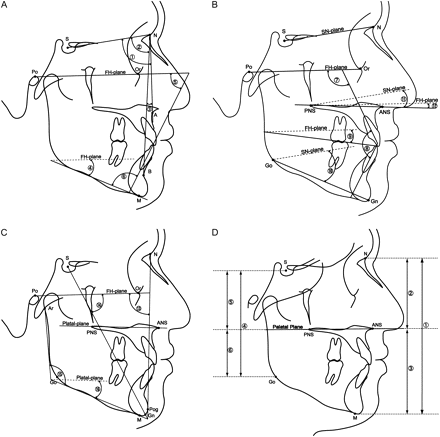Deleted member 14280
Silver
- Joined
- Jun 16, 2021
- Posts
- 570
- Reputation
- 848
Basically this study confirms positive consequences on chewing according to PSL standards
The aim of this study was to investigate the relationship between masseter muscle size and craniofacial morphology, focusing on the maxilla. Twenty-four patients (11 males and 13 females; mean age 27.6 ± 5.6 years) underwent cephalometric analyses. Ultrasonography was used to measure the cross-sectional area (CSA) of the masseter muscle and bite force was measured using pressure sensitive film.
The results showed that CSA-relaxed was positively correlated with upper anterior face height (UAFH)/total anterior face height (TAFH) and negatively with lower anterior face height (LAFH)/TAFH and LAFH (P < 0.05). CSA-clenched was correlated positively with SN-palatal, FH-palatal, UAFH/TAFH, and lower posterior face height (LPFH)/total posterior face height (TPFH) and negatively with LAFH/TAFH, LAFH, upper posterior face height (UPFH)/TPFH, and UPFH (P < 0.05). Bite force was positively correlated with LPFH/TPFH and negatively with UPFH/TPFH (P < 0.05). As the masseter became larger, the anterior maxillary region tended to shift downwards relative to the cranial base, whereas the posterior region tended to shift upwards. The decrease in LAFH/TAFH and increase in LPFH/TPFH as the size of the masseter muscle increases may be influenced not only by the inclination of the mandibular plane but also by the clockwise rotation of the maxilla.
 TLDR: WITH INCREASED MASSETER SIZE (CHEWING), THERE IS CCW ROTATION AND INCREASE IN POSTERIOR FACIAL HEIGHT ( MAKING THE MANDIBLE GET CLOSER TO BEING PARALEL TO FRANKFURT PLANE ) AND DECREASE IN ANTERIOR FACIAL HEIGHT ( SHORTER MIDFACE )
TLDR: WITH INCREASED MASSETER SIZE (CHEWING), THERE IS CCW ROTATION AND INCREASE IN POSTERIOR FACIAL HEIGHT ( MAKING THE MANDIBLE GET CLOSER TO BEING PARALEL TO FRANKFURT PLANE ) AND DECREASE IN ANTERIOR FACIAL HEIGHT ( SHORTER MIDFACE )

 academic.oup.com
academic.oup.com
BEST OF THE BEST RN @Gargantuan @her @thecel
The aim of this study was to investigate the relationship between masseter muscle size and craniofacial morphology, focusing on the maxilla. Twenty-four patients (11 males and 13 females; mean age 27.6 ± 5.6 years) underwent cephalometric analyses. Ultrasonography was used to measure the cross-sectional area (CSA) of the masseter muscle and bite force was measured using pressure sensitive film.
The results showed that CSA-relaxed was positively correlated with upper anterior face height (UAFH)/total anterior face height (TAFH) and negatively with lower anterior face height (LAFH)/TAFH and LAFH (P < 0.05). CSA-clenched was correlated positively with SN-palatal, FH-palatal, UAFH/TAFH, and lower posterior face height (LPFH)/total posterior face height (TPFH) and negatively with LAFH/TAFH, LAFH, upper posterior face height (UPFH)/TPFH, and UPFH (P < 0.05). Bite force was positively correlated with LPFH/TPFH and negatively with UPFH/TPFH (P < 0.05). As the masseter became larger, the anterior maxillary region tended to shift downwards relative to the cranial base, whereas the posterior region tended to shift upwards. The decrease in LAFH/TAFH and increase in LPFH/TPFH as the size of the masseter muscle increases may be influenced not only by the inclination of the mandibular plane but also by the clockwise rotation of the maxilla.
 TLDR: WITH INCREASED MASSETER SIZE (CHEWING), THERE IS CCW ROTATION AND INCREASE IN POSTERIOR FACIAL HEIGHT ( MAKING THE MANDIBLE GET CLOSER TO BEING PARALEL TO FRANKFURT PLANE ) AND DECREASE IN ANTERIOR FACIAL HEIGHT ( SHORTER MIDFACE )
TLDR: WITH INCREASED MASSETER SIZE (CHEWING), THERE IS CCW ROTATION AND INCREASE IN POSTERIOR FACIAL HEIGHT ( MAKING THE MANDIBLE GET CLOSER TO BEING PARALEL TO FRANKFURT PLANE ) AND DECREASE IN ANTERIOR FACIAL HEIGHT ( SHORTER MIDFACE )
Relationship between masseter muscle size and maxillary morphology
Abstract. The aim of this study was to investigate the relationship between masseter muscle size and craniofacial morphology, focusing on the maxilla. Twenty-fo
BEST OF THE BEST RN @Gargantuan @her @thecel




